To be Undeterred
This week in history, May 14-20:
- The U.S. Supreme Court declines True Father’s appeal (May 14, 1984)
- 33 Couples’ Holy Blessing Ceremony is held (May 15, 1961)
- The Sun Myung Moon Christian Crusade kicks off (May 15, 1974)
- Citizens Federation for the Unification of the Fatherland is inaugurated (May 15, 1987)
- True Father begins a 17-nation speaking tour in South America (May 16, 1995)
- The Washington Times begins publication (May 17, 1982)
- The Washington Times celebrated its 25th anniversary (May 17, 2007)
- Rev. Paul Werner pioneers Austria (May 18, 1965)
- A U.S. jury returns the guilty verdict against True Father (May 18, 1982)
- Clergy and Rabbis sign the Jerusalem Declaration (May 18, 2003)
- True Father initiates Il Jeung (“One Heart”) prayer (May 19, 1984)
- True Father enters Heungnam Prison (May 20, 1948)
- True Parents declare the Day of the Love of God and bequeath Ae Chun candles (May 20, 1984)
May 14, 1984
U.S. Supreme Court Declines True Father’s Appeal
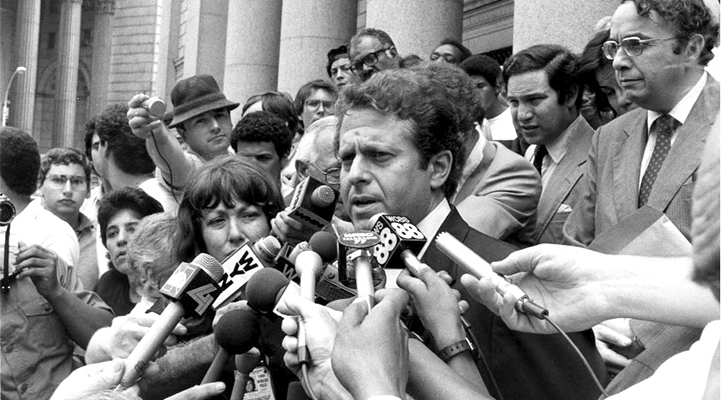
Harvard Law scholar Lawrence Tribe speaking on True Father’s court proceedings at the Federal Court House in New York.
In his book Inquisition, The Persecution and Prosecution of the Reverend Sun Myung Moon, Pulitzer Prize-winning journalist Carlton Sherwood argued that True Father’s 1981 conviction on tax evasion charges was the result of “the most intensive and expensive criminal tax investigation of any religious figure in U.S. history.” However, the conviction had the effect of generating broad-based public support for True Father. By April 1984, forty groups and individuals representing more than 120 million Americans had filed amicus curiae briefs in support of his appeal, including the National Association of Evangelicals, the National Conference of Black Mayors, the National Bar Association, The Church of Jesus Christ of Latter-day Saints, the attorneys general of Hawaii, Oregon and Rhode Island, Eugene McCarthy and Clare Boothe Luce. The Supreme Court’s refusal on May 14, 1984, to review True Father’s petition, despite this groundswell of support, set off a series of “Rallies for Religious Freedom.” Even The Washington Post, no friend of the church or the competing Washington Times, editorialized that “the case deserves attention and full Supreme Court review.” Ironically, the church emerged from True Father’s conviction on more solid ground than it had been before.
May 15, 1961
33 Couples Holy Blessing Ceremony is Held
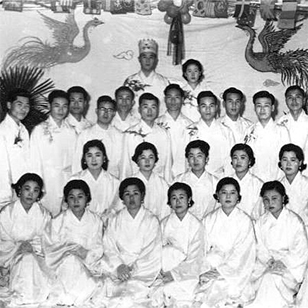
True Parents conducted the 33 Couple Holy Blessing in the Chungpa-Dong Church Headquarters on May 15, 1961. Together with the Three Couples whom True Parents blessed on April 16, 1960, they comprise the 36 Couple Blessing group. True Father called them the “ancestors” of all the blessed couples to come after them. He also regarded them as “the representatives of all types of people on earth” and viewed them as being needed to “pave the way to the Kingdom of Heaven and act as guides for others.” True Father explained that the 36 Couples consisted of three groups of 12, symbolizing the Old Testament, New Testament and Completed Testament ages. They also were wedded in three phases: the first at dawn, the second during the day, and the third at night. True Father recalled that the 33 Couple Blessing Ceremony was held “amid great confusion and chaos.” He noted, “The parents of the 33 Couples came swarming about the place, shouting all kinds of insults at us and creating a continuous uproar. Some went so far as to send dozens of anonymous letters to the court of justice, demanding I be sent to jail; as a result, I had to appear in court on several occasions.” According to True Father, the parents were upset that he “brought together other people’s children and married them at my own discretion, without discussing it with the parents at all.” He recalled, “We finally had to have someone stand guard at the door before we could go through with the ceremony.”
May 15, 1974
The Sun Myung Moon Christian Crusade Kicks Off
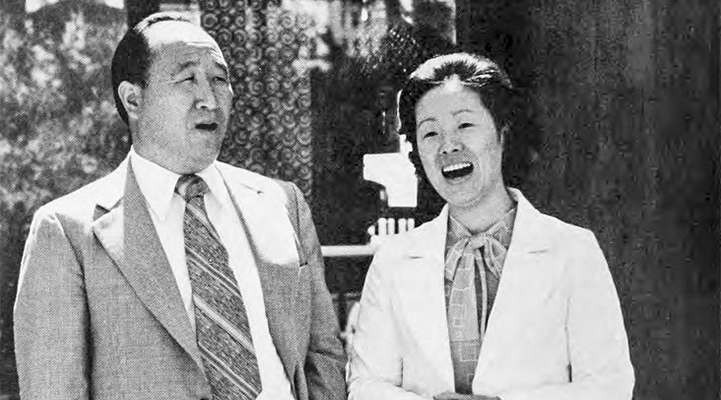
The Unification movement hoped to reap a harvest of new members as a result of True Father’s 7-City, 21-City and 32-City Day of Hope tours from 1972 to 1974. To facilitate this, the movement launched a Sun Myung Moon Christian Crusade (SMCC) 10-city “Celebration of Life” tour that evangelized in each of the ten regions of the country. Beginning in the Bay Area, the itinerary included stops in Seattle; St. Paul, Minnesota; Austin, Texas; New Orleans; Miami; Columbus, Ohio; Louisville, Kentucky; Boston; and Rochester, New York. Billed as “A 21st Century Experience,” programs included an hour and fifteen minutes of entertainment—songs, solos, skits, dances and testimonials—followed by forty-five minutes of inspiration from “God’s Colonel” Bo Hi Pak, on key points of the Unification Principle. Weeklong stops in each city featured a Celebration of Life weekend workshop.
As a result of tour innovations, advance preparation and media coverage, the Celebration of Life drew substantial crowds. SMCC’s “World Premiere” from May 15 to 17, 1974, at the Paramount Theatre in Oakland, California, drew 2,600 guests and 34 participants for a weekend workshop in the Santa Cruz Mountains. By Boston, the three-day total was up to 7,562. Equally important was the emergence of the New Hope Singers International and the Korean Folk Ballet. Both would make signal contributions to the culminating eight-city Day of Hope tour, scheduled to begin in September 1974 at Madison Square Garden in New York City.
May 15, 1987
Citizens Federation for the Unification of the Fatherland Inaugurated
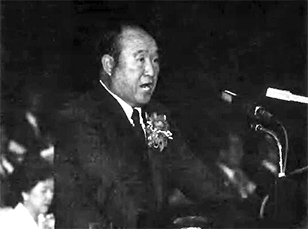
True Father inaugurated the Citizens Federation for the Unification of the Fatherland (CFUF) at the Little Angels Performing Arts Center in Seoul, Korea, on May 15, 1987. Its purpose was to facilitate the long-cherished hope and desire of the Korean people for the unification of their homeland. However, True Father viewed the re-unification of Korea in larger terms: “Korea’s problems are a smaller version of the world’s problems, and the solution of the world’s problems is essentially linked with Korea’s problems.” In particular, he saw the division of Korea as a manifestation of a global confrontation between theism and atheism. The solution to the problem was Godism and “Head-wing” thought which transcended the “ego-centered or power-oriented” thought of left- and right-wing movements.
True Father launched CFUF at a propitious time. He noted that the movement of international communism was “coming to its final phase” and that Korea was about to emerge on the world stage through the 1988 Seoul Olympics. This opened the way for the founding of the Segye Times newspaper, True Parents’ eventual meeting with North Korean President Kim Il Sung and activities promoting peaceful reunification that followed. CFUF, as a grassroots and high-level educational movement, played a significant role in these developments.
May 16, 1995
True Father Begins a 17-Nation Speaking Tour in South America
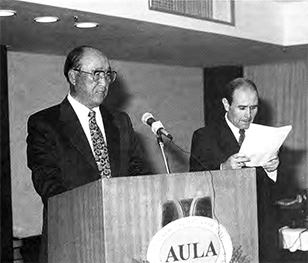
True Father believed that the unity of North and South America was a providential necessity that would set a condition for the unification of North and South Korea. To that end, he launched CAUSA activities in Latin America during the 1980s and began investing directly in South America during the 1990s. Beginning on May 16, 1995, True Father undertook an ambitious speaking tour of 17 Latin American nations, which included audiences with eight heads of state. In these speeches and meetings he emphasized the region’s “stunning, and abundant, potential.” As he put it: “There are seemingly unlimited natural resources, and the human energies have hardly begun to be tapped. Latin America is a rich, peaceful, natural paradise of grandiose mountains and virgin lands. The mountains, rivers and jungles [hark] back to the original state of creation, the Garden of Eden.” Contemplating “the glory-filled days that await Latin America in the 21st century,” he counseled leaders to “not follow the footsteps of the developed nations,” blindly repeating “environmental errors” and falling into selfish materialism.
True Father hoped to persuade the governments of the Mercosur customs union (Brazil, Argentina, Paraguay, Uruguay, Bolivia and Chile) to donate contiguous lands for development “as a model for an ideal, international and interracial nation and world.” However, when they did not step forward sufficiently, Unificationists businesses began purchasing vast tracts of land in the South American interior. The assumption was that if the leaders of North and South America, or elsewhere, could not respond to True Father’s vision of unification, they would have to be shown a working model. Thus began the South American providence to which substantial resources were dedicated in the late 1990s.
May 17, 1982
The Washington Times Begins Publication
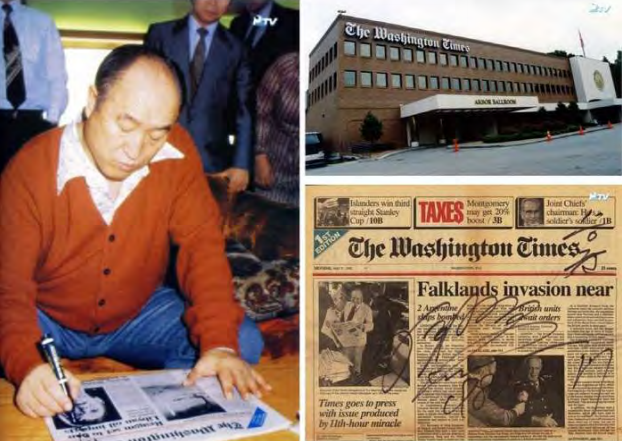
The Washington Times, a daily newspaper, published its first issue on May 17, 1982. Publishing tens of thousands of papers every morning and having a headquarters located in Washington, D.C., it became the second largest newspaper in the nation’s capital after The Washington Post. True Father spoke of the significance behind the establishment of The Washington Times, saying that he had started a newspaper, a business that even affluent people were giving up on, to save the United States and what was then known as the Free World. (Materials provided by the FFWPU History Compilation Committee)
May 17, 2007
The Washington Times’ 25th Anniversary
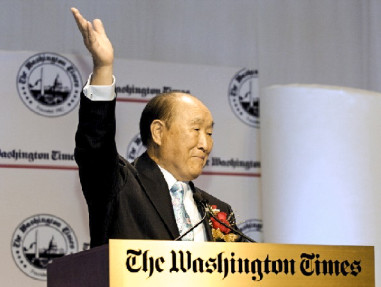
Under the theme “A Quarter Century of Dedication and Distinction,” The Washington Times observed its 25th anniversary with a gala event at the National Building Museum in Washington D.C. More than 1,100 leading figures in politics, culture, and journalism representing 82 nations took part in the celebration. U.S. President George W. Bush, UN Secretary-General Ban Ki Moon, Lady Margaret Thatcher, Polish Prime Minister Jarosaw Kaczynski, and Sri Lanka President Mahinda Rajapaksa were among those who sent messages of congratulations. Former President George H.W. Bush delivered the keynote address complementing the Times for challenging “what many of us felt was a prevailing liberal bias” and thanked True Father “for his vision in launching this newspaper,” reminding the audience that “without him, there would be no Washington Times.” True Father delivered the Founder’s Address, “A Providential View of the Pacific Rim Era in Light of God’s Will,” which he had originally delivered in Hawaii and, now with True Mother, was delivering worldwide. He noted, “The development of human civilization has completed a circuit of the entire globe and has arrived at the Pacific sphere.” Human history, he declared, “has come to a point in time in the providence at which it should reach completion and fruition through the Pacific Rim region.”
May 18, 1965
Rev. Paul Werner Pioneers Austria
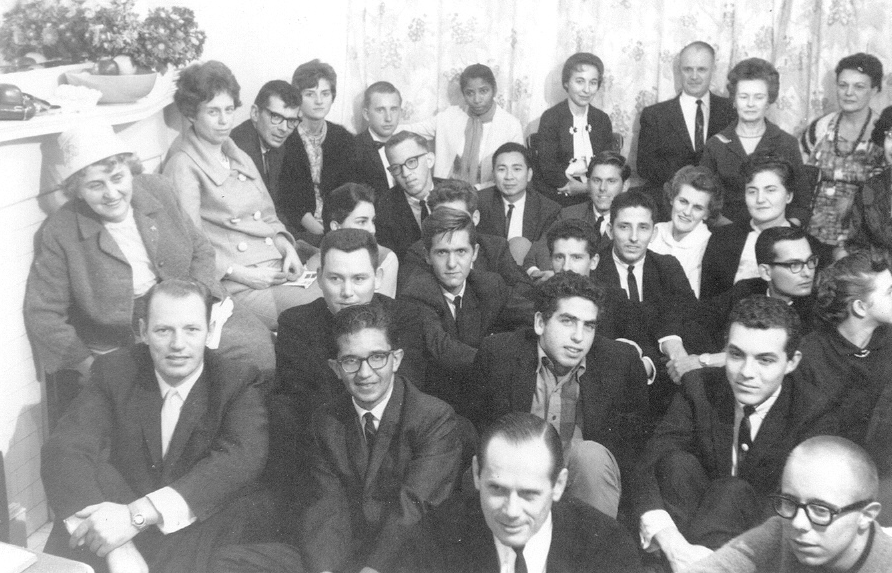
Paul Werner (lower left) at a meeting in San Francisco, circa 1964.
Rev. Paul Werner, his wife, Christel, and their son, Klaus, were among a group of German Unificationists who joined in the San Francisco Bay area under Dr. Young Oon Kim during the early 1960s. In April 1964, the Werners returned to Germany, where they joined Peter Koch who had returned the previous year. On May 18, 1965, Rev. Werner left for Austria, becoming the first missionary going out from Germany. He traveled there alone in a Volkswagen van, which was his “center” for the next half-year. Rev. Werner wrote, “I prayed day and night and fasted most of the time.” With Rev. Werner as driver, his VW van also served to transport True Father across Europe during True Father’s first world tour in 1965. Over time, Rev. Werner won members, established centers and founded the Austrian church. On May 18, 1969, four years to the day after Rev. Werner’s arrival in Austria, True Father asked him to lead the German movement and for Peter Koch to take over leadership of the movement in Austria.
May 18, 1982
U.S. Jury Returns Guilty Verdict against True Father
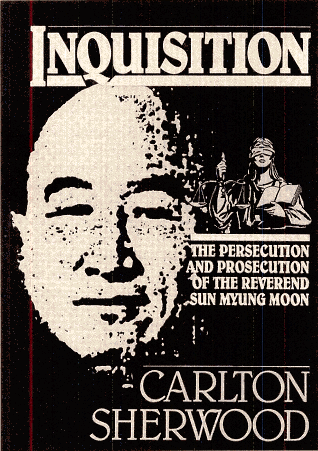
The cover of Inquisition, by Pulitzer prize-winning author Carlton Sherwood
The Unification Church won a series of court cases in 1982. After several years of struggle, it gained unambiguous legal recognition as a bona fide religion with full tax-emption privileges, public solicitation rights, and access to missionary visas. It also was able to extend civil rights protections to members and successfully press for damages against deprogrammers. However, the church lost the one case that was the most highly publicized, most costly, and that mattered to it the most; this was The United States v. Sun Myung Moon. Tax convictions have been a time-honored way to root out undesirables, and although the review process makes this more difficult to do within the American legal system, there has been a tendency for the politically ambitious to go after unpopular figures. In True Father case, a letter from U.S. Senator Robert Dole to the IRS Commissioner, which called for an audit of the church, led to what Carlton Sherwood termed “the most intensive and extensive criminal tax investigation of any religious figure in U.S. history.”
The odd thing about True Father’s case was that it continued to move forward in the face of so many obstacles. First, the audit of his tax returns for 1973–1975 showed a total liability of $7,300, less than the $2,500 per year required by IRS guidelines for criminal prosecution. Second, three career attorneys from the U.S. Justice Department questioned whether there was any liability at all and signed off on a written memorandum that prosecution was not warranted. Third, the prosecuting attorney had to convene three grand juries before gaining the necessary indictments. Fourth, jury members who, according to the trial judge, met the criteria of being people who “don’t read much, don’t talk much, and don’t know much” had to sift through over 2,000 documentary exhibits and technical argumentation that glazed the eyes of even trained legal observers over. In the end, neither True Father nor the movement was able to stem the government’s determination to gain a conviction. The trial began on April 1, 1982 and lasted approximately six weeks. On May 18, 1982, the jury returned its verdict against True Father.
May 18, 2003
Clergy and Rabbis Sign the Jerusalem Declaration
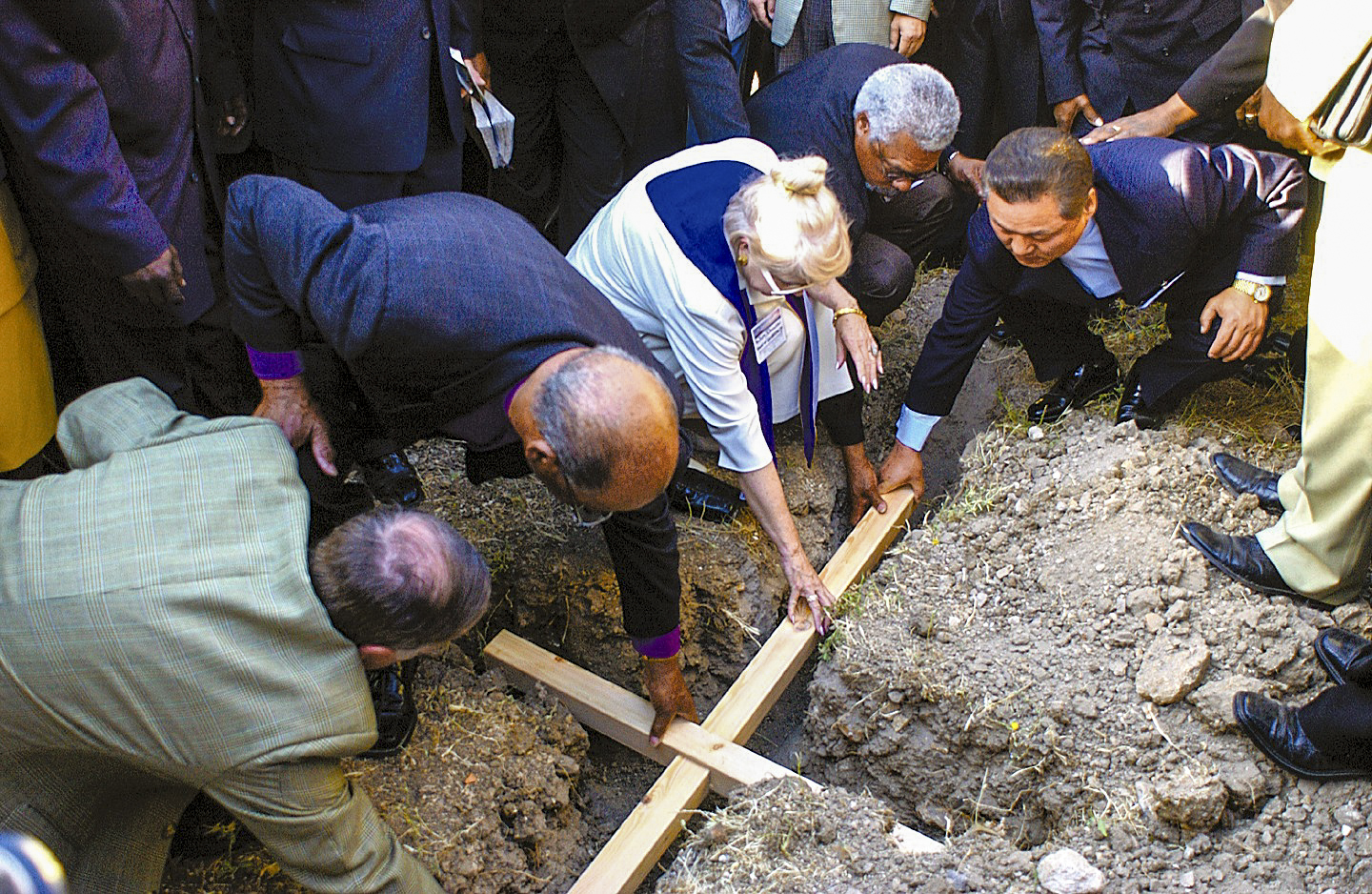
May 18, 2003, was a momentous day of the first Middle East Peace Initiative (MEPI) Holy Land Peace Pilgrimage. U.S. clergy awoke early and left their hotel in busses at 5:30 a.m. to go to the Church of the Holy Sepulcher. It was fortunate they left at this time because at 6:00 a.m. a suicide bomber set off a blast two blocks from the hotel, killing seven people and injuring 22. All traffic was stopped and had the clergy left any later, they would not have been able to pass. From there, they offered a 30-minute service at the site of Golgotha and then traveled a mile or so to the Potter’s Field, also referred to as the Field of Blood, which, according to Matthew 27, the chief priests purchased with the 30 pieces of silver Judas got for betraying Jesus. Pastors lifted a wooden cross, about six feet high, as they marched down a winding road to the Potter’s Field. At the site, ministers placed the cross in a hole previously dug to its exact dimensions by Israeli FFWPU members. They placed a FFWPU flag, “dated and signed by representative leaders,” on top. The ceremony concluded with participants putting “soil on the cross one-by-one, repenting for the false faith” that was “preventing Christianity and Judaism from achieving reconciliation.”
On that foundation, the 135 U.S. clergy met with a similar number of Israeli rabbis as well as ten imams for a day-long “Conference for Jewish and Christian Reconciliation and Harmony.” The highlight of this was the Jerusalem Declaration in which the clergy and rabbis repented “for the dark parts of our past” and sought “a bright future together.” In reality, it was not easy to obtain the signatures. According to one report, “the main rabbi strongly rejected…signing his name.” In addition, “Some rabbis were upset that the declaration would even be considered.” However, in an unscripted moment, a key rabbi stated, “I will sign it if my Moslem brother will sign it with me.” A leading sheik marched forward and “the three brothers collapsed into an embrace.” One observer recounted, “This opened the floodgates and everyone rushed to the front to sign.”
May 19, 1984
True Father Initiates Il Jeung (“One Heart”) Prayer
True Father initiated the Il Jeung (“One Heart”) prayer association on May 19, 1984. He declared that the sovereignty of God’s true love finally had moved from the individual, family, and national levels to the worldwide level. In order for them to inherit God’s love, he called on Unificationists to establish a tradition of offering prayer conditions. He invited each member of the worldwide Unification Church, according to his or her individual schedule, to offer a prayer vigil from midnight to 4:00 a.m. once each forty days. He also asked each member to make a one-day (or at least one-meal) fasting condition once every forty days and to establish an Il Jeung Fund. These conditions were especially important in maintaining movement solidarity during the period in which True Father was imprisoned at Danbury.
May 20, 1948
True Father Enters Heungnam Prison
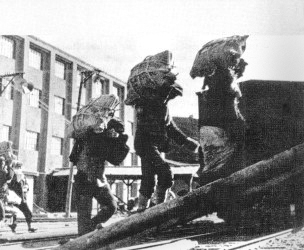
After being arrested for the second time in North Korea on February 22, 1948, True Father was charged with being a spy for the South and for disturbing the social order. Some 80 Christian ministers who had lost members to True Father’s group precipitated this action by writing letters to the police. True Father was once again tortured and wrote later, “My body still carries several scars that I received then.” He went on trial on April 7 and was convicted. He wrote in his autobiography, “Many of the most famous ministers in North Korea came to the courtroom and accused me of all manner of crimes.” That day he was taken to Pyongyang Prison where he remained until he was transported to Heungnam on May 20, nearly three months following his arrest. True Father wrote, “I felt indignation and also shamed before heaven. I was tied to a thief so I could not escape. We were taken by a vehicle on a route that took 17 hours. As I looked out the window a powerful feeling of grief welled up inside me. It seemed incredible to me that I would have to travel this winding road along rivers and through valleys as a prisoner.”
May 20, 1984
True Parents Declare the Day of the Love of God and Bequeath Ae Chun Candles

At 12:54 a.m. on May 16, 1984, True Parents established the Day of the Love of God and created Ae Chun (“Love of God”) candles. This was two days after the U.S. Supreme Court declined to review True Father’s petition that his 1981 conviction on tax evasion charges be overturned. On May 20, True Parents declared the day to Unificationists and also bequeathed Ae Chun candles to them. The Ae Chun candles exist as a pair. One is referred to as a “Father” candle and the other, a “Mother” candle. As they represent the harmony and love of the True Parents, the candles are always to be burned together. It was understood that Ae Chun candles should be burned during prayer for a high-level purpose—i.e., national, world or cosmic level. In his prayer to God, True Father said, “Wherever this candle burns, may the family be united, and may that family have peace, connecting with the sovereignty of Your love through this light.”
This Week in History briefly lists significant events in the history of the Unification Church, the lives of the Founders, and world events that are momentous to Unificationists. Most items are marked according to the solar calendar. Items marked “H.C.” correspond to the Cheon-gi or Heavenly Calendar, which is based on the lunar calendar. This installment covers the week of May 14-20.
Contributed by Dr. Michael Mickler, Professor of Church History at the Unification Theological Seminary.


Shahram Sedehi
| #
This is amazing compilation done with so much depth. Thankyou Dr. Mickler!
Reply